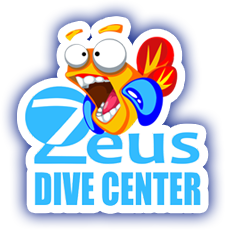Dive Sites in Gran Canaria
Gran Canaria offers a wide variety of dive sites.
Here is a description of some of the most notable sites:
Dive in Gran Canaria with Zeus Dive Center
Gran Canaria is an authentic paradise for sea lovers, with water temperatures ranging from 18°C (in February) to 24°C (in October/November). Prevailing sea currents create large schools of fish close to the coast, and the amazing seabed features are the region’s key natural advantages. Gran Canaria is a great diving destination that’s open all year round. There are interesting scuba diving areas spread all around the coast of Gran Canaria. For divers of all levels, there are amazing dive spots. Want to find out why so many people are addicted to scuba diving? Shake off your stress and come discover all the magic hidden under the sea in Gran Canaria.
Arinaga – El Cabrón
In the rugged coastal zone of the Agüimes municipality, the best dive site on the island can be found: El Cabrón. The richness of marine life in the area is so great that it has been nominated to be included in the future Arinaga Marine Reserve.
This area is considered one of the top 5 dive sites in Spain. With different entry and exit points, it offers dives for all levels, from beginners to professionals, all of whom will be amazed by the variety of life and beautiful marine landscapes.
Different entries from volcanic rocks lead to a descending reef that ranges from 6 to 12 meters across the dive site. It’s very common to see damselfish, parrotfish, trumpetfish, barracudas, nudibranchs, and moray eels.
There is a drop-off to about 23 meters where you can find caves, cracks, and arches that are perfect for more technical divers. The sandy bottom is home to stingrays, angelsharks, and a huge school of grunts that give their name to an area in El Cabrón: the Roncadores.
For more experienced divers, there is an area with gerardia and gorgonian corals at a depth of about 30 meters, with currents that can range from moderate to strong. On the way to the gerardia and gorgonian corals, you can find groupers, barracudas, amberjacks, and sardine shoals, as well as angelsharks and different types of rays.
El Cabrón will surprise you on each of your dives, and you’ll be happy to have experienced and enjoyed the astonishing underwater world.
Sardina del Norte
Sardina dives are well known for their simplicity. Access the water from the old staircase port (the brave can jump from the top). There are two distinct areas.
The first covers the right profile of the cliff, reaching a depth of 16 meters. Here, you can see schools of grunts, sardines, barracudas, garden eels, and more.
The second area covers the central lower sandy bay with rocks, where you can find electric rays, butterfly rays, octopuses, moray eels, seahorses, (giant) anemones, nudibranchs, cuttlefish, and more.
The angelshark is present nearly all year round in the sandy area of the bay.
Arinaga – Risco Verde
Risco Verde is not far from El Cabrón beach. It offers easy dives, full of small fish and sometimes larger visitors such as butterfly rays and electric rays. The angelshark can also be found here. The maximum depth is about 13 meters, making it a dive site suitable for all ages and levels. The entrance and exit are fairly easy, and for night dives, it’s one of our favorite sites.
The bottom can be sandy, rocky, or covered with seaweed, and many small and tiny sea life can be found.
If we go further out of the bay, we will find one of the biggest schools of grunts in Gran Canaria. Currents are common here, and the maximum depth can be up to 20 meters.
Dives in the Best Dive Sites of Gran Canaria
Dive with us into the most iconic destinations of the island.
– In the Southeast: El Cabrón, Risco Verde.
– In the South: Mogán Wreck, Arguineguin Biotope, Pasito Blanco.
– In Telde: Tufia, Ojos de Garza.
– In Las Palmas: La Catedral, Roque Ceniciento, El Arona, El Frigorífico.
– In the North: Caleta de Abajo, Sardina del Norte.
Discover the richness and diversity of these places through our exciting dives.
